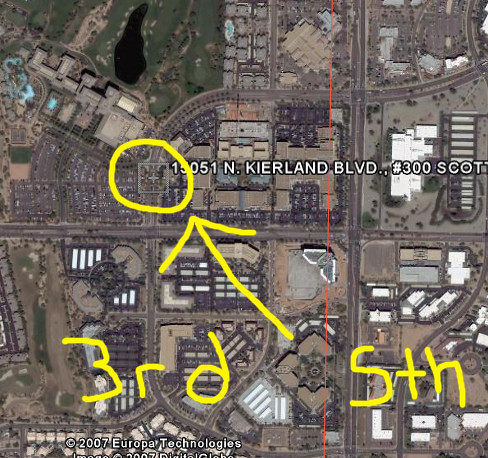As I hinted at back in January, Congress is learning that it can't have it both ways with the Defense Reutilization and Marketing Service:
Of roughly $1.8 billion worth of equipment the Defense Department downgraded to scrap from January through June, at least $330 million worth came from categories of gear the Pentagon most frequently buys back from surplus dealers, according to the National Association of Aircraft & Communication Suppliers. Those include parts for aircraft, weapons and communications systems, the group said.

The association, a lobbying group for surplus dealers, is worried the military's recent decision to shred retired F-14 "Tomcat" fighter jets is the start of a broader effort to destroy Pentagon leftovers that surplus dealers once bought routinely. Iran is aggressively seeking F-14 components for its own aging Tomcat fleet.
[snip]
Rep. John Shadegg, R-Ariz., wrote to Lt. Gen. Robert Dail, director of the Defense Logistics Agency, asking whether surplus equipment is being scrapped, including new items such as Camelbak backpack-style hydration packs.
"I have received reports that usable items such as sleeping bags and gloves, and auto parts such as mufflers, are being scrapped because DRMS has stated that it is unable to identify them," Shadegg wrote in the letter, which was obtained by The Associated Press. The DRMS is the Pentagon's Defense Reutilization and Marketing Service.
Shadegg said he also is concerned about the loss of government revenue from surplus sales and about harm to small businesses in the surplus industry.
Contrast this with what Representatives Shays had to say about DRMS back in January:
"The military should not sell or give away any sensitive military equipment. If we no longer need it, it needs to be destroyed - totally destroyed," said Shays, until this month the chairman of a House panel on national security. "The Department of Defense should not be supplying sensitive military equipment to our adversaries, our enemies, terrorists."
Shadegg's interest isn't too surprising, considering that DRMS's main contractor, Government Liquidity LLC is located in the Pheonix suburb of Scottsdale. A quick check of Arizona's Congressional map puts Scottsdale inside Shadegg's 3rd District.
Aside from Shadegg's personal political interest in DRMS sales, I do agree with his sentiment as a fellow taxpayer. The Department of Defense should try to recoup some of its costs by surplusing excess or antiquated hardware -- but that's just me.

I can also see why the DRMS folks are taking the cautious route by choosing to scrap a larger percent of their surplus. Sure, Camelbaks, binoculars and boots seem like fairly innocuous items, but if they are "specifically designed, developed, configured, adapted, or modified for a military application," they may be classified as defense articles under part § 120.3 of the International Trafficking in Arms Regulation.
When it comes to items that have commercially-available equivalents, defense article determinations are up to State Department policy wonks and Immigration and Customs Enforcement investigators. There are often few publicly available guidelines for this grey area, so it is easy to see why DRMS is choosing to err on the side of caution by scrapping everything that raises questions.
None of this is the fault of DRMS, State or ICE. Each agency is simply doing its job in an ambiguous legal environment. This isn't a hard problem to solve either. Congress just needs to decide whether recouping some of the DoD's annual price tag is as important as maintaining the current export control regime and then pick one or the other. Its not realistic for the Congress to simply assume that bureaucrats or their contractor minions can overcome these conflicting priorities.
A problem like this requires a political solution crafted by elected officials. Heck, its what we hire them to do.
Update: Reader Tom T. suggests a third route, "Let Shays and Shadegg settle their dispute over DRMS in a bare-knuckle boxing match on the House floor." Normally, I would throw my support behind such a proposal, but I'm afraid the House's Sergeant at Arms would end up indicted like Mike Vick. Zing!
Second Update: J and a few other readers familiar with Scottsdale, Arizona were quick to point out that most of the town is actually located in the 5th Congressional district. Having more than a passing familiarity with that area myself, I looked into the matter shortly after reading the military.com article cited above. With the aid of Scottsdale's Chamber of Commerce and the Congressional districts layer of Google Earth, I discovered that Government Liquidation is indeed in the 3rd distrct by a few hundred feet. Here is a screen capture (the red line is district border):


2 comments:
Good post, but don't be to quick when looking at congressional districts. Government Liquidation LLC is not located in Shadegg's district. It is located in Arizona's 5th congressional district, which is represented by the Harry Mitchell (D) (who knocked Rep. Hayworth (R), a close friend of Shadeggs, out of office). Kierland is a beautiful part of Snottsdale.
J - I have some family in the Kierland area of Scottsdale, so I initially thought Government Liquidation was in the 5th district as well. That seemed to conflict with the substance of the Military.com story, so I looked up the address provided on Scottdale website.
Kierland is split between the 3rd and 5th districts and it turns out 1501 N. Kierland Blvd. is a few hundred feet into the 3rd district side.
Hayworth was such a d-bag. I'm glad he's gone.
Post a Comment